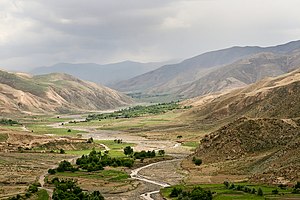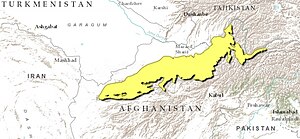Eco-814: Paropamisus xeric woodlands
Source: Wikipedia
| Paropamisus xeric woodlands | |
|---|---|
 | |
 Ecoregion territory (in purple) | |
| Ecology | |
| Realm | Palearctic |
| Biome | Deserts and xeric shrublands |
| Geography | |
| Area | 92,804 km2 (35,832 sq mi) |
| Country | Afghanistan, Tajikistan |
| Coordinates | 36°15′N 66°45′E / 36.25°N 66.75°E / 36.25; 66.75 |
The Paropamisus xeric woodlands ecoregion (WWF ID: PA1322) covers the portion of northeastern Afghanistan north of the central mountain range and the Hindu Kush Mountains. The name is derived from the Old Persian name for the region, Parupraesanna ("Beyond the Hindu Kush"). While there are low canopy woodlands in the northeast of the ecorgegion, most of the territory is desert or xeric (dry) scrubland.[1][2][3][4]
Location and description
The ecoregion stretches for 1,100 kilometres (680 mi) across northern Afghanistan, from the city of Herat in the west to the Wakhan Corridor in the east. The territory is on the north slopes of the mountains of central Afghanistan and the Hindu Kush. To the north is the Badghyz and Karabil semi-desert ecoregion, to the south are the Ghorat-Hazarajat alpine meadow and Hindu Kush alpine meadow ecoregions.
The terrain is rugged: elevations range from 371 metres (1,217 ft) to a high point of 5,592 metres (18,346 ft).[3]
Climate
The climate of ecoregion is Cold semi-arid climate (Köppen climate classification (BSk)). This climate is characteristic of steppe climates intermediary between desert humid climates, and typically have precipitation is above evapotranspiration. At least one month averages below 0 °C (32 °F).[5][6]
Flora and fauna
Over 80% of the ecoregion is dry shrub. Another 8% is cultivated in crop agriculture (mostly along river valleys), and another 8% is sparse vegetation or bare ground.[3] Common vegetation is thornbush, Ziziphus (Ziziphus nummularia and Ziziphus spina-christi), Acacia (Vachellia tortilis and Vachellia flava) Pistacia atlantica, Larix griffithii, Pinus roxburghii, Pinus hwangshanensis, Juniperus tibetica, Shorea robusta, Olea europaea subsp. cuspidata, Tsuga dumosa, Taxus sumatrana, Betula utilis, Alnus nepalensis, Betula alnoides, Betula utilis, Picea brachytyla, Juglans regia, Larix gmelinii, Larix sibirica, Larix × czekanowskii, Betula dahurica, Betula pendula, Pinus koraiensis, Pinus sibirica, Pinus sylvestris, Picea obovata, Abies sibirica, Quercus acutissima, Quercus mongolica, Ginkgo biloba, Prunus serrulata, Prunus padus, Tilia amurensis, Salix babylonica, Acer palmatum, Populus tremula, Ulmus davidiana, Ulmus pumila, Pinus pumila, Haloxylon ammodendron, Elaeagnus angustifolia, Tamarix ramosissima, Prunus sibirica, Cathaya argyrophylla, Taiwania cryptomerioides, Cyathea spinulosa, Sassafras tzumu, Davidia involucrata, Metasequoia glyptostroboides, Glyptostrobus pensilis, Castanea mollissima, Quercus myrsinifolia, Quercus acuta, Machilus thunbergii, Tetracentron, Cercidiphyllum japonicum, Emmenopterys henryi, Eucommia ulmoides, Olea europaea, Balanites aegyptiaca, Cupressus sempervirens, Salix alba, Populus nigra, Quercus coccifera, Pinus nigra, Ceratonia siliqua, Arbutus unedo, Erica arborea, Laurus nobilis, Prosopis cineraria, Pinus halepensis, Toona ciliata, Aerva javanica, Prunus amygdalus, Juniperus communis, Quercus brantii, Quercus robur, Quercus petraea, Picea abies, Abies alba, Alnus glutinosa, Fagus sylvatica, Taxus baccata, Acer pseudoplatanus, Malus sylvestris, Viburnum lantana, Fraxinus excelsior, Tilia cordata, Aesculus hippocastanum, Rhamnus cathartica, Ulmus glabra, Ulmus minor, Populus alba, and Corylus avellana. There are areas of woodland in the northeast of the ecoregion in Badakhshan Province, featuring wild almond, pistachio, willow, and buckthorn trees.[4] There are no endemic vertebrates, but the isolated areas support a range of non-endemic threatened and endangered species, including the near threatened Argali (Ovis ammon), the vulnerable Goitered gazelle (Gazella subgutturosa), the endangered Kulan (Equus hemionus), the near threatened Mountain weasel (Mustela altaica), and near threatened Sand cat (Felis margarita).[4]
Protected areas
Less than 1% of the ecoregion is officially protected.[3][7] These protected areas include the Dashti-Jum Nature Reserve in Tajikistan.
References
- ↑ "Paropamisus xeric woodlands". World Wildlife Federation. Retrieved March 21, 2020.
- ↑ "Map of Ecoregions 2017". Resolve, using WWF data. Retrieved September 14, 2019.
- 1 2 3 4 "Paropamisus xeric woodlands". Digital Observatory for Protected Areas. Retrieved August 1, 2020.
- 1 2 3 "Paropamisus xeric woodlands". The Encyclopedia of Earth. Retrieved August 28, 2020.
- ↑ Kottek, M.; Grieser, J.; Beck, C.; Rudolf, B.; Rubel, F. (2006). "World Map of Koppen-Geiger Climate Classification Updated" (PDF). Gebrüder Borntraeger. Retrieved September 14, 2019.
- ↑ "Dataset - Koppen climate classifications". World Bank. Retrieved September 14, 2019.
- ↑ Dinerstein, Eric [in German]; Olson, David; Joshi, Anup; et al. (2017-04-05). "An Ecoregion-Based Approach to Protecting Half the Terrestrial Realm". BioScience. 67 (6): 534–545, Supplemental material 2 table S1b. doi:10.1093/biosci/bix014. ISSN 0006-3568. PMC 5451287. PMID 28608869.
External links
- Media related to Paropamisus xeric woodlands at Wikimedia Commons